|
|
|
|
|
|
|
|
|
|
|
|
|
|
|
|
|
|
|
|
The word Newgrange is derived from New Grianan which means New Sunhouse and it was built by, and is the tomb of, Aengus the Ard ri (High-king) of Tara, who reigned in the latter-half of the sixth century B.C. and whose name is carved in Ogham Script on Stone C4 in the West Recess inside the tomb.
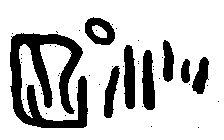
The hieroglyphics on Stone C4 in Newgrange's West
Recess
that show a "ship" (with four passengers: - Jeremiah;
Teia Tephi and her two hand-maidens) and spell
the word "Aengus" carved in Ogham Script.
On the East side of stone C4 there is carved a date-palm with a wavy line attached to it. This date-palm represents queen Teia Tephi, Aengus' mother who came to Ireland by sea over the waves from Jerusalem and confirms that the Aengus referred to in Ogham script, on the same stone, was indeed the third child of Teia Tephi and her husband the Daighda, Eochaidh mac Duach/Dui, the High-king of Tara. Aengus was also known as "in Mac Oc" (the Young Son). Part of the Ogham Script has also been described as a ship, which is further proof of Aengus' relationship with Teia Tephi, his mother, who came by ship from Jerusalem to Ireland with Jeremiah the Bible Prophet. Teia Tephi landed with Jacob's Pillar Stone, the Bethel - Lia Fail Stone, at Howth on the 18th of June in 583 B.C.
West Recess

Queen Teia Tephi had The Mound of The Hostages (2 Chron. 25:24) built for her at Tara Hill and named "Teamur" - "Teia's Wailing-Wall'; where she wailed over the destruction of her native Jerusalem, just as people do today by the "Wailing-Wall" in Jerusalem itself. It was also called Duma na Gaill, meaning "Purity of Palms", according to the Irish Metrical Dindsenchas, Part 1; page 17; line 39. The Mound of The Hostages/Teamur was so called, because, before being covered with earth at a later date, it was the wall where the Palm (Teia Tephi) fasted; prayed and purified herself. A later Jerusalem - Palm link is "Palm-Sunday."
Aengus' mother; the daughter of king Zedekiah of Jerusalem; called Teia Tephi, who was brought from Jerusalem to Ireland by Jeremiah (the Bible Prophet who was buried in Cairn T, at nearby Loughcrew) wrote in her autobiography that Aengus was very arrogant and that he would worship money and build the grandest tomb in Ireland for himself to be immortalised in human-memory but that it would be violated and ransacked by future invaders and grave-robbers.
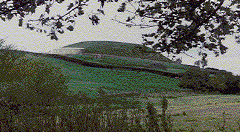
Newgrange, the grandest tomb in Europe.
It was ransacked and robbed, by the vikings exactly as his mother prophesied after seeing a vision, a copy of which is in the "Book of Tephi Queen of Tara", which includes many other prophecies that she was given by God and which have been fulfilled in minute detail.
Because of his mother's prophecy concerning his tomb; that he knew would be fulfilled, for Teia Tephi was God's Chosen Seed and the Tender Twig (daughter) of the lofty Cedar (line of David) that Jeremiah uprooted from Jerusalem and planted in Ireland (Jeremiah 1:10), as he was commanded to do by God; Aengus had the blue-prints / building-plans carved into stone and placed in and around his tomb. He did this so that the tomb could then be rebuilt if it was badly damaged by the prophesied future raiders.
Jeremiah 1:10 See, I (God) have this day set thee (Jeremiah) over the nations and over the kingdoms, to root out, and to pull down, and to destroy, and to throw down, to build, and to plant.
The carvings you can see on the stones are astronomical calculations, done in great detail, without which it would have been impossible to construct and align the tomb and its roof-box aperture with the Winter Solstice sunrise. The vertical lines on kerbstones K1 and K52, which are on opposite sides (at the front and the back respectively) of the tomb are sighting-marks for lining-up the passage with the Winter Solstice sunrise.
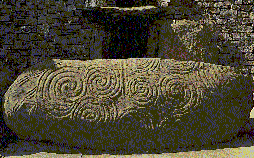
Kerb-stones K 1 (above) and K 52 (below).
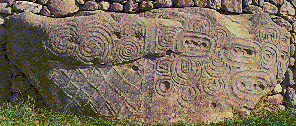
It was the Winter Solstice (the original pagan Yuletide) that was believed to be the time both of death and rebirth, in pagan Baal-worship, and so the tomb was lined up in order that Aengus could be reborn when the sun (worshipped as a god by Baal-worshippers) pierced his tomb and the beam of light touched his remains.

The light of the Winter Solstice entering the passage at Newgrange.
Aengus believed that he could then travel along the light-beam to the sun and join his god and become divine himself. This belief was common in many parts of the world especially in Egypt, where the Celts, who are all Israelites, had been in slavery for 400 years, until Moses delivered them from slavery in the Exodus, after which some of them came to Ireland as Celts. Aengus's great pride and his belief expressed by his tomb caused him to be wrongfully deified, like the pharaohs, by his subjects.The word Celt is the anglicised version of the Greek word Keltoi, which means the "people who are different" i.e. Israelites. The whole world according to God is populated by Gentiles, with Israelites being the minority who are "different" (as expressed in Deuteronomy 14:2 of The Torah - The Law) because they were commanded to keep only God's Laws - The Torah, which is buried in The Ark of The Covenant at the Hill of Torah-Taueragh-Tara. Israelites were to be a "peculiar people" unto the Lord i.e. "different from other people".
Deuteronomy 14:2 For thou [art] an holy people unto the "I AM" thy God, and the "I AM" hath chosen thee to be a peculiar* people unto Himself, above all the nations that [are] upon the earth.
* Special; Different (Oxford Dictionary).
The other people who came to settle in Ireland were/are the Tuatha de Danaan which means the Tribe of Dan, which was/is the fifth Tribe of Israel (Genesis 30:6), so, they too, like the Celts, are Israelites.
Genesis 30:6 And Rachel said, God hath judged me, and hath also heard my voice, and hath given me a son: therefore called she his name Dan.
The tomb itself is designed as an enormous cosmic egg, which was originally completely covered by quartz stone crystals, that absorb and retain the sun's energy, just like quartz-crystals absorb energy in many modern watches and clocks.
It is egg-shaped to act as a womb within which was placed the remains of Aengus and the entrance-passage represents the uterus up which the fertilizing ray of the Winter Solstice sunrise enters the womb; supposedly impregnates and gives new life to the occupant to be reborn, making them immortal, or, as in Aengus' case immortalised in human-memory because of his magnificent tomb. This tomb is not just the grandest tomb in Ireland, it is reputed to be the grandest in Europe.
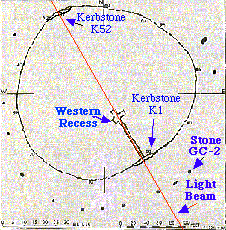
Plan of the tomb, showing the large standing stones
that were used to
align the tomb and also the Kerbstones. The vertical
lines on K1 and
K52 along with the large standing stones shown
below were used to
align the passage and roofbox with the Winter Solstice
sunrise.
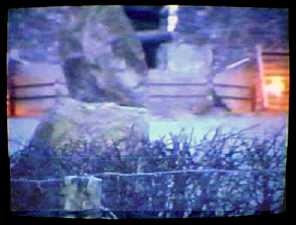
Alignment of Standing Stones and Winter Solstice Sunrise.
The large Standing Stones around Newgrange; as well as being used for sighting and surveying benchmanks to line it up with the Winter Solstice sunrise; were also used to align it with the other great cairns of Knowth and Dowth. Standing Stone GC-2, which stands on top of Bronze-age burial pits, was used along with Mound 6 to line-up Newgrange with Knowth, which is the oldest of the three cairns. Other Standing Stones around Newgrange were used to align Newgrange with Dowth which is the next oldest; Newgrange being the youngest of the three.Ireland has large copper deposits, and, using tin from Cornwall, the Irish people manufactured bronze. That is why Ireland used bronze rather than having to buy iron and is also why the Bronze-age continued in Ireland well into what was already the Iron-age in other parts of the world. Ireland had copper-mines at least 3,000 years ago when the Phoenicians (Israelites) and others from the Mediterranean area first began sailing here to buy bronze. It still has the largest copper-mines in Europe today.
Standing Stone GC -2 and the other Standing Stones date from the Iron-age, not the Bronze-age, during the latter-part of the sixth century B.C., which is when Aengus was the Ard ri of Tara; his mother having died on the Calends (first) of August in 534 B.C.
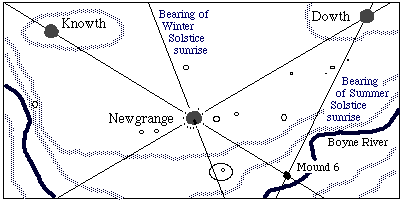
Map showing various Boyne Valley Alignments
Aengus, Teia Tephi's third child and her second son (known as "In Mac Oc" - the Young son), was raised at Mullagh, Co. Cavan, by his aunt Maistiv, who was reputed to have been the best embroideress in Ireland; after his elder brother Aedh's death. Mullagh Hill where Aengus was raised is not far away, being just over the Meath border in neighbouring County Cavan.
Aengus' older brother; Aedh, Teia Tephi's firstborn; died whilst still a teenager and was buried in the passage of the Mound of The Hostages on Tara Hill, and so Aengus inherited the throne in his place. Tara Hill was the Capital of Ireland and is well worth visiting, not only because of its history and because it is still the Spiritual Capital of Ireland, but also because of its natural unspoiled beauty and the spectacular view of the surrounding country-side from the top of The Mound of The Hostages*.
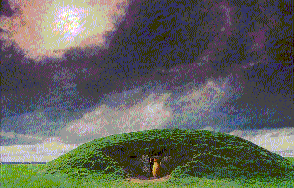
The Mound of The Hostages at Tara.
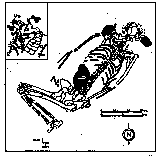
Aengus' Older Brother Aedh's Remains,
found wearing faience beads; given to Teia Tephi by
pharaoh
Hophra when she stayed at Tanis before she came to
Ireland; by O' Riordain (1955)
* The words "The Hostages" are used only once in the entire Bible, in the Old Covenant / Testament Second Book of Chronicles:-
25:24 And [he took] all the gold and the silver, and all the vessels that were found in The House of God, . . . the hostages also, and . . . .
Evidence from:-Newgrange Archaeology, Art and Legend
by Michael J. O’KellyGeorge Petrie, who made the first Ordnance Survey of Tara c. 1837, stated; as recorded by Professor O’Kelly on page 35:-
George Petrie was one of the first to place Newgrange in its proper perspective, . . . . He also re-established the link between Newgrange and the store of myth and saga enshrined in the references to Bru na Boinne in the early Irish literature. No matter that he wrongly (in O’Kelly’s opinion, which was based solely on the incorrect radiocarbon-dating of the cairn - JAH) attributed the mounds on the Boyne (correctly - JAH) to the ‘Tuatha de Danann’, the mythical semi-divine (which they were not because they were flesh and blood real people from the Israelite ‘Tribe of Dan’, one of Jacob’s twelve sons - JAH) ancestors of the Gael;
Professor Michael J. O’Kelly states on page 41:-
(Sean P.) O’Riordhain (Professor of Archaeology at University College Cork and Prof. O’Kelly’s teacher) said it was certain that “The stone (GC -10) was erected clear of the edge of the cairn and that it fell before any collapse (of the cairn) took place because none of the cairn material lay beneath it.” The orthostat and circle, therefore, must either be contemporary with the mound or earlier (and David Sweetman the chief archaeologist at Duchas / OPW has ascertained using rain-water-corrupted material that gave a radiocarbon reading for an earlier date than the real age, that these GC stones including GC -10 were erected post Bronze-Age [Iron-Age] - Technology Ireland; March 1991, page 23).O’Kelly on page 42:-
Officially it was regarded as a Bronze Age monument of perhaps 1500 BC or later (i.e. Iron-Age).A threepenny guidebook by R. A. S. Macalister, published in 1939, referred to it as a Bronze Age monument about 42 ft. in height above ground level at the entrance.
O’Kelly on page 46:-
From the Book of Lecan. The Daighda had three sons Aedh; Aengus (Mac Ind Oc, who built the cairn and after whom Newgrange is also named Brug Aengusa) and Cermaidh.O’Kelly on page 48:-
In the past three decades archaeologists, as a result of (unreliable - JAH) scientific dating techniques, have become accustomed to drastic revisions of chronologies which were previously held to be almost immutable. Radiocarbon dating has (wrongly, as explained below in the notes about page 87 - JAH) shown Newgrange to be a thousand years older than the date popularly assigned to it in pre-excavation days.O’Kelly on page 86:-
In every case the bottom course of the layer of cairn stones resting on a turf layer had become cemented on to it by a bright red deposit of iron oxide leached out (by water) from higher up in the mound. (So evidently there was iron ore present at the time of the building of Newgrange - JAH).Page 87:-
The divisions between the turves here (behind K 95 slightly to the East of K1 - JAH) were very clearly marked by lines of rust-red iron oxide leached out (by water) from above (i.e. the area from which the dating-samples were taken - JAH) and deposited in the interstices into which the leaching water was easily able to run (showing that there was a considerable washing/leaching-action taking place on the cairn, that must also have washed/leached out the radiocarbon from the dating-samples that were taken from material that was actually used as waterproofing-material - Sweeney; The Pyramid Age; Domra 1999, page 102, Velikovsky’s article 1972 The Pitfalls of Radiocarbon Dating).“As a matter of fact, the radiocarbon system is well-known and increasingly well-accepted by those in the field to have a number of major drawbacks. Velikovsky, who was never averse to challenging the “experts,” presented a fairly detailed overview of the problems as early as 1972 in an article entitled: The Pitfalls of Radiocarbon Dating. To begin with, Velikovsky said, samples can be contaminated, and it is virtually impossible to know that they have been. Contamination comes in many forms, and can either increase or decrease the readings, making the sample under investigation appear either much younger or much older than it is. The most simple, yet possibly the most pervasive form of contamination is that of water. Under some circumstances, water can literally wash (leach out) the radioactivity out of a sample, making it look older. But there is absolutely no way of knowing whether a control sample has been exposed to water. How then can we use radiocarbon readings of samples of wood, leather and bone recovered from the ground, when it is virtually certain that at some stage, even in Egypt, the ground has been soaked with rainwater? Yet such readings are regularly published without comment.”
O’Kelly, page 88; fig. 13; top diagram
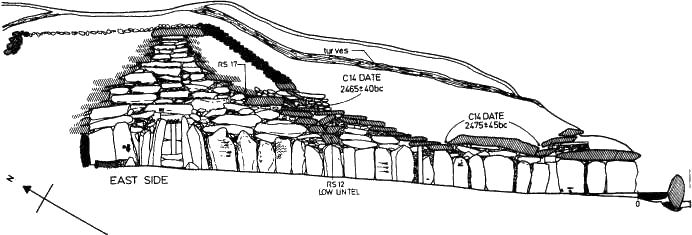
Shows that the samples that were used for radiocarbon dating of Newgrange were taken from the very wettest parts of the cairn, which is precisely why the material was needed in those particular locations as ‘putty’ for caulking (water-proofing) and demonstrates that they would have been constantly soaking-wet and subject to leaching-out of the radiocarbon material contained in them, making the readings appear much older than they really were, as explained above by Velikovsky and Sweeney. The samples taken from the front and rear of Roofstone 3 (R 3) were in locations that received so much water that, as well as using caulking material (‘putty’), special grooves had to be cut into the roof stones (R 3 and R 4) to help drain-away the water so it did not pour into the passage (p. 94) because the caulking alone did not stop the flow of water from soaking and running through the caulking ‘putty’ (leaching-out the radiocarbon material in the process) and into the passage.Page 90:-
It was also found that the inner-most turf layer in cutting K95 could be linked with the inner-most one found in the embrasure (therefore the water would have run from the higher inner-most turf, close to the place from where the dating samples were taken, down to the lower linked turf behind K95 where the leached-out iron oxide residue was found (see page 111*), proving a great amount of water-flow and leaching-out took place around and on the dating-samples).* Page 111 :-
Since the monument stands on a ridge and the ground beneath falls away to the North and South, the rain-water quickly runs down through the loose body of the cairn and when it meets the iron-pan-indurated surfaces of the layers of turves, or the pan-coated old turf surface beneath, the natural flow is to the North and South.Because water corrupts the dating-sample material by leaching-out the radiocarbon from the sample, making it appear much older than it really is, the radiocarbon dating of these two sets of samples is bound to give a reading much older than the real date. These readings therefore have to be discounted as a means of dating the cairn and other evidence, by which it can be dated, must be found.
Page 94:-
The front portion of its (a roof slab) upper surface has a natural shallow basin-like hollow which in wet weather, accompanied by a southeast or south wind, would fill with water and occasionally spill over and enter the passage. To prevent this, a water-groove had been cut from the West edge of the ‘basin’ to drain the water off and allow it to dissipate into the cairn outside the side of the passage (down the turves to the rear of K95 where the iron oxide residue was found - p. 86 - JAH).Page 100:-
From RS 8 onwards there are no grooves, nor is there any need for them as the rain-water runs down the ‘flight of steps’ to the point where the grooves on the flatter part of the roof collect it (where the ‘putty’ was needed - JAH) and run it off to the sides. We observed this for ourselves many times while the roof surface was exposed.Page 101:-
Another precaution taken to ensure protection for the monument consisted in packing the interstices of the passage roof with a mixture of burnt soil and sea sand. The burnt soil had been taken from a habitation area as it contained small quantities of animal-bone fragments as well as a few fragmentary flint artefacts. The sea-sand was used principally in the space under the ‘relieving arch structure where it was packed in before the burnt soil ‘putty’ had been put in place. So much of the latter was present (because of the great amount of water running down the ‘flight of steps’ - JAH) that it seemed probable it had been burnt specially for the purpose. The sea sand is identical with that on the present sea-shore around the mouth of the Boyne, 20 km. down river. Samples of the burnt soil provided (incorrect, for the reason already stated - JAH) radiocarbon dates centring on 2500 bc for the structure of the tomb (Appendix H).Having ascertained that the sample material has been corrupted by water-contamination; as testified to by Professor M. J. O’Kelly himself, other evidence must be found by which to date the cairn.
Page 105:-
There were no finds of pottery in the tomb (and nothing by which to date it - JAH).This is also confirmed by the fact that O’Kelly states on page 126:-
“ . . . nor was there any trace in the tomb of the Late Neolithic/Beaker period people who squatted around the edge . . .” (and there wouldn’t be any evidence of them building it, because it was not built until long after their time had passed, because the cairn was wrongly dated as being before instead of after their time - JAH).Page 215:-
Mammalia
The 116 bones that have been identified as dog belong to a minimum of three individuals. This number has been established by the find of one complete left humerus and two left distal humerus fragments.
The bone assemblage seems to consist of three partial skeletons, one from the East chamber (27 fragments), one from just outside the End chamber (44 fragments) and one from the West chamber (45 fragments). The individual from outside the End chamber (lot 1) could be studied in some detail. This was a large dog with a shoulder-height of c. 64 cm. The spinous processes of its thoracic vertebrae have rather irregular surfaces and three vertebral bodies exhibit signs of insipient spondylosis, a pathological condition that is generally brought about by old age (van Wijngaarden-Bakker and Krauwer 1979). The bones from the two other partial skeletons are similar in size to the one just described. The shoulder-height of Neolithic dogs, often described as the palustris-type usually does not exceed c. 50 cm as is indicated by the dogs from the Beaker settlement at Newgrange and by those Neolithic levels at Lough Gur (van Wijngaarden-Bakker 1974 and 1980). The large size of the present skeletons and above all their preservation condition with yellowish surfaces but white fractures strongly suggests a recent origin for the bones. Whether these skeletons belong to stray dogs that were unable to get out of the tomb or to dogs that were deliberately buried there remains speculative. (But not really if they died of old age, then they were burials, because strays would have died of starvation not of old age and could not have buried themselves - JAH. Iron-Age Celts frequently deposited the remains of persons of rank, with the favourite hunting dog in sacred cairns - John T. O’Flaherty, A.B. 26/1/1824, R.I.A.)There is therefore absolutely no reliable evidence whatsoever to indicate, and so nothing and absolutely no reason to date the Newgrange cairn as being Stone Age and a great deal of evidence; physical; oral and written; to the contrary.
This cairn was built, as legend and Ogham script within the cairn on Stone C4 in the West Recess tell us, by Eochaidh Ollathair the Daighda and his son from his marriage-union with Teia Tephi (Tailte) / Bovinda, called Aengus/Oengus Mac Ind Oc, who lived in the sixth century BC. - the Iron Age; not the Stone Age and from whom it acquired its rightful name - Brug Aengusa or Brug Maic Ind Oc.
The Daighda - Eochaidh Ollathair reigned from c. 633 B.C. for forty years. The Book of Lecan states that the Daighda had three sons :- Aedh; Aengus and Cermaidh.
(Celtic Myth and Legend) There is frequent mention of Bru na Boyne (Ptolemy of Egypt, the second century geographer, drew a map of Ireland and showed the river Boyne, calling it “Bovinda”. Giraldus of Wales called it Boandus - Boaengus) in manuscripts dating from the nine hundreds A.D. onwards, and there can be little doubt that it had a central part in oral tradition for many centuries before the legends were written down in the nine hundreds and since then. These Boyne passage-graves were particularly associated with the Tuatha de Danaan, who ruled Ireland before the coming of the Celts. Bru na Boangus was a palace of Eochaidh Ollathair the benevolent Daighda, his consort (wife) Bovinda (Teia Tephi) and his son Aengus. It was sometimes called “Caiseal Aengusa”.
In the thirteenth century (1200s) Book of Ballymote the scribe records that “the hosts of great Meath are buried in the middle of the lordly-Brugh.” It was the traditional burial-place for the kings of Tara.Aengus was the son of Eochaidh Ollathair, the Daighda, High-king of Tara who reigned at the beginning of the sixth century B.C. and according to the Annals of the Four Masters he died at Newgrange in ‘year of the world’ 3450 (554 BC) and so Newgrange is Iron-age NOT Stone-age. It was built in the sixth century B.C. with metal tools, using horses and carts to haul and transport the approx. 200,000 tons of stones.
The age of the cairn is also confirmed by the astronomical alignment of the cairn with the Winter Solstice sunrise at this time - 600 - 550 BC.
Instrumentation.
AUTOHELM Personal Compass, made in England. Digital compass. This instrument has a digital display giving bearings, on Magnetic North, with an accuracy of ±1/2° due to the fact that it gives bearings in whole degrees only.Methodology.
A reverse bearing was taken from a position approximately seven meters south-east of the outlier stone that is shown in the foreground in the two pictures below, which; at the very place on the stone (its top S-E corner) that was used for aligning the passage and roofbox with the Winter Solstice sunrise; has been cut and dressed, using metal tools. Since the instrument may be sighted in either direction, the reading was taken with it facing the operator, towards the sunrise position.
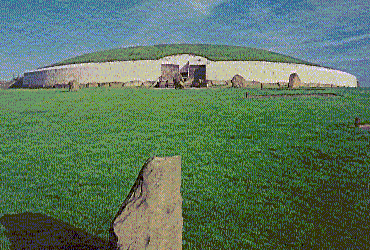 |
 |
Results.
A bearing of 140° MN was taken. A calibration factor of -7° 19’ was calculated from the grid data on Ordnance Survey map #43 (Discovery Series), giving an azimuth of 132° 41’. According to F. Prendergast (1989), the Winter Solstice sunrise in 3,150 BC was at azimuth 133° 54’ ± 4’. The alignment is, therefore, 1° 13’ to the North of the Neolithic Winter Solstice sunrise position, corresponding to 2,217 years. The result is a date of 933 BC (± 1,000 years, due to the accuracy of the instrumentation).With more accurate instrumentation this would give a correct reading of c. 550 BC, which would also corroborate the age of the cairn to have been built by Aengus (after whom it is named) and Eochaidh Ollathair - the Daighda, proving the accuracy and truth of some of the ancient Irish historical records, that have been discounted by the archaeologists in favour of their own theories based on unreliable radiocarbon dating. JAH.
Knowth is the English name for Cnogba "Nut Lamentation".
Magh Macha has a wood, rich in nut-clusters, in the western part, where the all-pervading aroma of the nuts used to excite the animals. Emain Macha - Navan Fort was Nuadh's home. As Nuadh was the much loved brave and honourable king of Ulster who lived at Emain Macha - Navan; Knowth is probably Nuadh's Grave, where he was buried after he fell at the Battle of Unna (Destruction) opposing Bressail "Bodibal" mac Elatha and the people lamented his death. The tomb entrance-passage faces the entrance of Dowth so that Nuadh and Bressail would face and oppose each other forever. Around the tomb are many satellite graves which would be the graves of the soldiers of lesser rank that fell with Nuadh during the battle, whilst defending Teia Tephi, who was later wrongfully deified as the goddess Bovinda (Heifer), or Bo for short. The Battle of Destruction was fought nearby, at Slane.Legend has it that Lughaidh "Lamhfhada" (long-hand) also known as "Crom Dubh" (the one bowed to the black haired heifer - Teia Tephi), the son of the great Ith Cian, the king of Spain, buried his wife at Knowth.
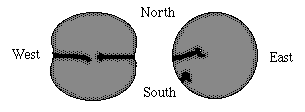
Dowth - Dubad "Darkness"
Dowth - Dubad "Darkness" is the tomb of Bressail "Bodibal" mac Elatha, the son of Elatha ruler of Cornwall in the sixth century B.C. Bres was a very handsome man, loved by the Irish women for his good looks but hated by the menfolk for his greed and meanness.Bres lived in Ireland for some years and was made the champion and regent of Nuadh of the Silver Hand, king of Ulster, for seven years, during which time he hoarded wealth and made the menfolk's lives a misery. On receiving notice from Cornwall he went home to fetch and escort Teia Tephi, the mother of Aengus who built Newgrange, from Cornwall to Tara, years before Aengus was born.
At Tara, after Tephi was inaugurated as queen of all Ireland, the people complained to her about Bres, so she arranged an election in which he was removed as regent. His laws and taxes were then abolished and The Torah put in their place. At that point a number of kings and warlords in the already divided and war-torn country of Ireland joined Bres and rebelled against Tephi, because under The Real Law of The Torah, that she brought, they would have to give back all the wealth that they had un-fairly stolen from the people under their own laws and taxes that they had made up themselves. A huge battle then transpired, known as the Battle of Unna (Destruction), where all of the rebel kings and warlords and their armies led by Bressail the son of Elatha of Cornwall, fought against Teia Tephi and her army. As Teia Tephi was fighting for God and His Laws, her army defeated all of the rebels in the battle which was held at Slane, called the Battle of Unna (Destruction), which commenced on 31st October of 583 B.C. and lasted for four days.
On the 27th October of 583 B.C., four days before the battle commenced, there was a Lunar Eclipse in the Constellation of Taurus, when the Moon would have looked blood-red and would have been interpreted as an "Omen of Death" and defeat for the Baal-worshippers, whose symbol is the bull. Taurus being the sign of the bull. The Baal-worshippers led by Bressail mac Elatha (known in legend as Bressail "Bodibal" - "Bo destroyer") fought to destroy God's Chosen, Teia Tephi (Bo) at the Battle of Destruction, but failed. This Lunar Eclipse is shown in hieroglyphics in Jeremiah's Tomb, Cairn T at Loughcrew, nr. Oldcastle.
There was a total of six thousand six hundred and sixty-eight people killed in the Battle of Unna. Five thousand and sixty-three of whom were on Bressail's side including forty-two kings from various regions of Ireland, and the rest of the British Isles. From Teia Tephi's army, only sixteen hundred and five were killed, those of rank from both sides that fell at the battle were buried at Knowth and those of lower rank were buried in the many satellite graves around Knowth and through-out the Boyne Valley.
Bressail, the leader of the rebels, although defeated, wasn't killed in the battle and after swearing allegiance to Teia Tephi and The Torah was sent out to help clear the sea of Fomorians (pirates). The people never forgot his meanness and arrogance and when he died he was buried in the tomb that was made to face the setting sun rather than the sunrise and his tomb was named Dowth which is derived from the old Gaelic word, Dubad, meaning darkness. He had fought for the lord of Darkness against God the Lord of Light, attempting to defeat and destroy God's Chosen, Teia Tephi and God's Perfect Law - The Torah.
We hope you have enjoyed your visit and that you will tell your family and friends and that we shall see you again to wish you once again - "Cead Mile Failte".
When travelling through and visiting the Heritage sites and beautiful Royal Meath in general, PLEASE take only photographs and leave only footprints. Thank You. JAH.
The autobiography of Aengus' mother, queen Teia Tephi, that she wrote in her palace at Teltown, is called the "Book of Tephi Queen of Tara and Gibraltar". It is absolutely full of ancient-historical and prophetical information including prophecies about the near future. It is a fascinating book written in verse, like the famous Irish Metrical Dindsenchas, and costs only £10.
Map of sites related to Jeremiah The Prophet,
Teia Tephi, The Lia Fail Stone and
The Ark of The Covenant.
The following is quoted from the
"Book of Tephi Queen of Tara."
CHAPTER 31
A lamentation of Tephi wherein she giveth instruction.
To be
sung to the harp upon the two thousand four hundred
and
eighty-fourth day (1950).
O, my child, O, Aedh my firstborn, and O, Aedh my firstborn child,That lay small and warm on my heart and looked in mine eyes and smiled
As a flame* thou hast seared my breast, and wert by a flame beguiled.
O, fair was my strong son Aedh, and O Aedh, my strength, was fair.
The skies were seen in his eyes. The sun was set in his hair.
The Mighty hath slain my son. I mourn, yet He might not spare.
O, mine eyes are rivers of tears, and O, rivers of tears are my eyes.
I sat in the seat of folly. I walked not amongst the wise.
I sowed a seed of destruction. Its fruits are foulness and lies.
O, let evil be upon Canaan, and O, upon Canaan be every ill.
Why hale ye their women hither, that are harlots on every hill,
That are brazen in dances to Baal, that are wanton in all their will?
O, hear me, my chosen, my husband, and O, my husband, my chosen, hear.
I have erred and have done great evil. My burden is heavy to bear.
This mocking was mine not thine. Yet my shame hath been thine to share.
O, heed me Aengus, my son, and O, Aengus, my son, take heed.
Thy brother is black in the pit. He stinks as a rotten reed.
Thou barest the branch of blessing. Thy Stone is chosen for seed.
Yet I know thee, O, Aengus, my son, and O, Aengus, my son, I know
Thy pomp and thy pride of heart. Thy flame burneth on and fro (Deut. 17:20).
It flashes fire in the sky. Its light is sunken and low.
I divine thee, O Aengus, my son, and, O Aengus, my son, I divine
Thy spirit unscarred by the thorns. Thou shalt seek only the gold of that sign (the cross).
Thy heart is not with the High One**. With sinners thou sittest at wine.
I behold thy grave§, O, my son, and thy grave, O, my son, I behold.
Thy grave-mound is glorious and great. Thou graspest there on thy gold,
Yet the heathen shall find thy hoard ere the hill of thy height wax old.
O, thy treasure is heaped upon earth, and O, with earth is thy treasure-heap.
Thou art e'en as the kings of Egypt. Thou sinkest down in thy sleep.
But thieves shall find thee therein, and the snail and the slow worm creep.
Thy toiling is waste, O Aengus, and, O Aengus, waste is thy toil.
Thy masons build thee a mansion. The spoiler shall make it a spoil,
For thy zeal is not unto Zion, nor thine heart anointed with oil.
O, may the Bright Reign come by thee, and O may my White King come.
His sheep He leadeth in spirit. He rebuketh them lest they roam.
He blesseth their lambs in His Bosom. They hear Him at "Eve" and go Home.
O, hear ye the Promise of Israel, and O, Israel, this promise hear.
Let your watchmen know of the "Night". Let them count when the stars grow clear.
Let them strongly shout in the Gate (Gibraltar) if a presage of "Dawn" appear.
O, rest ye your faith upon David, and O on David let fealty rest.
In righteous judgments He rideth. His wise men gaze from the West.
His house on the hill-tops is holy. His Symbols shine on His Breast (The Breastplate of Aaron).
O, He rides as a King in Glory, and O, in glory my King doth ride.
The nations are scattered beneath Him. In their eyries the eagles hide.
As a lion He leaps in His strength. What man shall His might abide?
O, springs gush out by the Hill, and O, from the Hill there gush forth springs.
O'er the path of his chosen people, the vessels bear wealth unto kings.
The ships of the sea pass over. The waters are white with their wings.
O, broad is the stream of Jordan, and O, Jordan thy streams are broad.
The seas have set thee in might. No steed shall swim by thy ford,
Where the House of the High One is builded, the Holy House of the Lord.
O, now I depart in peace, and O, peace is my part as I go.
I have lived the days of my life. I have joyed and wandered in woe.
I am feeble and fain would rest, from my travelling to and fro.
But O, that day I am fain to behold, and O, I fain would behold that day.
Raise up the stones from my sidhe+. Cleanse ye my bones from the clay.
Let me see the Son of my Strength, for my spirit shall be his stay.
* Aedh, a flame.
** Deuteronomy 17:14-20.
§ Aengus, of the Brugh, is now best remembered by his enormous tumulus (Newgrange), which was plundered by the Danes, exactly as Tephi prophesied. Aengus is also known as "In Mac Oc", which means "The Young Son."
+ Tumulus with chamber at the centre, pronounced "shee".
I wish to fulfill her final request to have the stones raised up from her sidhe and her bones cleansed from the clay at Tara, so she can see the Son of her Strength and her spirit be his stay: to finally bring lasting peace to Ireland and let the "Bright Reign" come. Amen - JAH
|
|
|
|
|
|
|
|
|
|
|
|
|
|
|
|
|
|